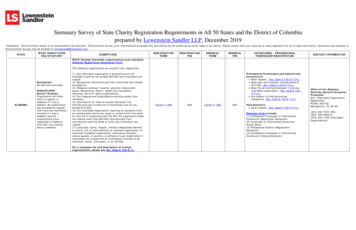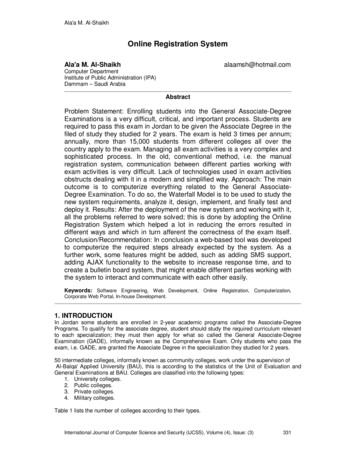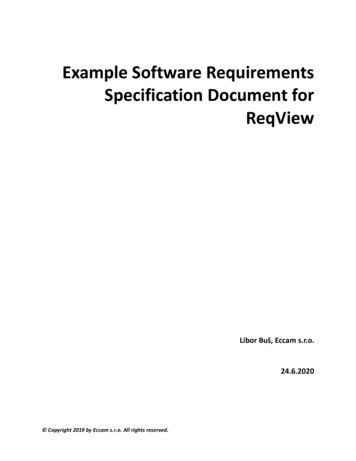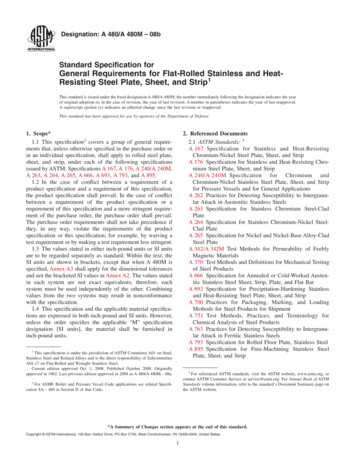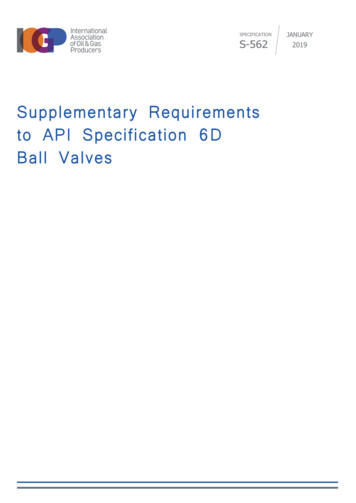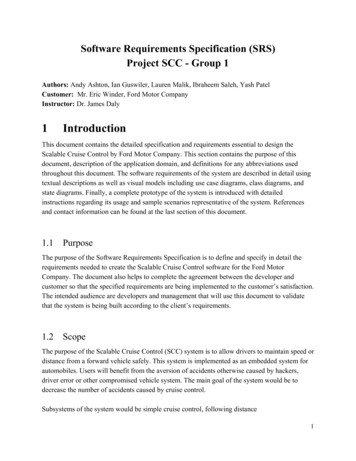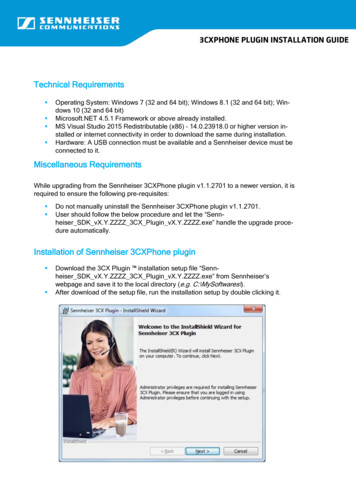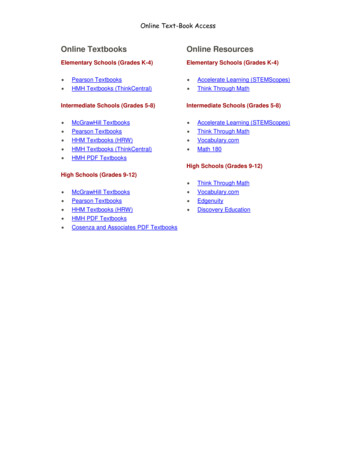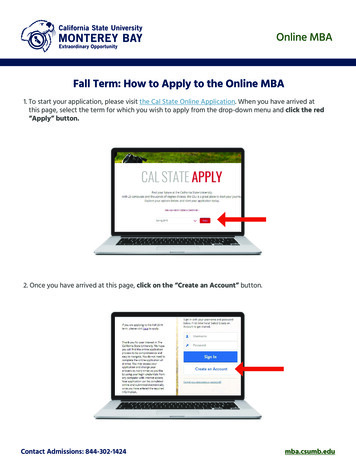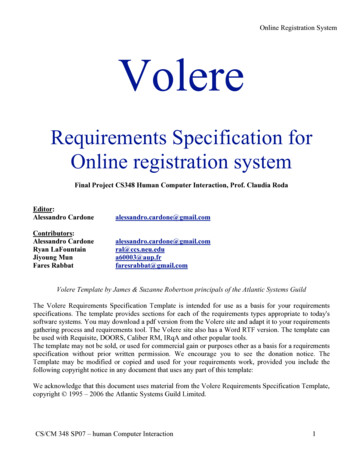
Transcription
Online Registration SystemVolereRequirements Specification forOnline registration systemFinal Project CS348 Human Computer Interaction, Prof. Claudia RodaEditor:Alessandro essandro CardoneRyan LaFountainJiyoung MunFares 60003@aup.frfaresrabbat@gmail.comVolere Template by James & Suzanne Robertson principals of the Atlantic Systems GuildThe Volere Requirements Specification Template is intended for use as a basis for your requirementsspecifications. The template provides sections for each of the requirements types appropriate to today'ssoftware systems. You may download a pdf version from the Volere site and adapt it to your requirementsgathering process and requirements tool. The Volere site also has a Word RTF version. The template canbe used with Requisite, DOORS, Caliber RM, IRqA and other popular tools.The template may not be sold, or used for commercial gain or purposes other as a basis for a requirementsspecification without prior written permission. We encourage you to see the donation notice. TheTemplate may be modified or copied and used for your requirements work, provided you include thefollowing copyright notice in any document that uses any part of this template:We acknowledge that this document uses material from the Volere Requirements Specification Template,copyright 1995 – 2006 the Atlantic Systems Guild Limited.CS/CM 348 SP07 – human Computer Interaction1
Online Registration SystemContentsProject Drivers1. The Purpose of the Project2. The Client, the Customer, and Other Stakeholders3. Users of the ProductProject Constraints4. Mandated Constraints5. Naming Conventions and Definitions6. Relevant Facts and AssumptionsFunctional Requirements7. The Scope of the Work8. The Scope of the Product9. Functional and Data RequirementsNonfunctional Requirements10. Look and Feel Requirements11. Usability and Humanity Requirements12. Performance Requirements13. Operational and Environmental Requirements14. Maintainability and Support Requirements15. Security Requirements16. Cultural and Political Requirements17. Open IssuesProject Issues18. New Problems19. Tasks20. Migration to the New Product21. Risks22. Costs23. User Documentation and TrainingAppendixCS/CM 348 SP07 – human Computer 212
Online Registration System1. The Purpose of the Project1a. The User Business or Background of the Project EffortThe American University of Paris does not provide an internet system that allows the students to reservethe classes for an incoming semester.The existing system only allows users to browse course schedules and create a mock up of their proposedschedule. Users can currently view course sections, times, and professors. The current system identifiesconflicts within the schedule and alerts the user to these conflicts. It does not submit this mock scheduleto an advisor for approval. The schedule created on the current system must be taken to the registrar'soffice and the classes must be manually scheduled by hand.The only advantage currently given by the internet is the process of browsing the classes, but it does notprovide an official registration. It only displays the possible options that the student can have according tothe classes offered in the chosen semester. As a consequence, at the end and the beginning of every singlesemester the registrar’s office is invaded by students who need to obtain the official approval for theclasses that they picked on the Internet and then transcribed manually on paper. Furthermore surprisinglyoften the requested classes are full, or there is some sort of a conflict in the schedule. Therefore thestudent needs to redo the whole schedule once again, until the latter is not approved by the registrar. Eachand every student must see his/her personal advisor before scheduling classes. Once this meeting iscompleted, the student must go to another office and have a meeting with another member of theadministration. This member of the registrar's office must manually transcribe the student's printedschedule into the registrar system which is different from any system the student has access to.Also the drop-add process is extremely laborious and it creates unacceptable queues. The goal of the system we are designing is to automatically all the necessary information to registerstudents for the coming semester. It will be connected to the AUP database and it will instantaneouslyrefuse all the unfeasible requests, saving many ours of waiting and work to students, faculty, and staff.Furthermore, subject to agreement with the appropriate stakeholders, the system might provide manyuseful services such as:An efficient and detailed description of the classes under many aspects;The notification of the most overloaded class to the registrar;The possibility of creating a waiting list for the students who want to have access to some classes withdrop-add;A more efficient classification of the hierarchy according to which the students can register.If the program turns out to be successful, the faculty will gain in time, work and money and the studentswill gain in time, work, energies and satisfaction regarding the classes that they are going to attend.The program will be one of many tools used by the university to help students manage their universitycareer. Users will be full time and part time students of AUP as well as faculty and administrators(registrar's office etc).The reasons why the University needs such a program are several and heterogeneous. This device:Would save a massive amount of work to the registrar’s office, with directly consequent economicalgain as well as conservation of time; It would provide a more efficient and satisfactory schedule for the client (students); It would provide clear and precise statistical information (such as the students’ interest and the mostrequested classes) that would probably be useful for future reference. CS/CM 348 SP07 – human Computer Interaction3
Online Registration System Furthermore, the program would also provide a great service to the students:It would provide a better chance to obtain the desired classes, which would directly influence thescholastic career and, therefore, the working career;It would make it possible to register for the coming semesters without physically being in Paris;It would take less time to conclude the registration process;It would spare the enormous amount of time wasted on the stares of the Bosquet building waiting fortheir turn during the drop-add period.The students are particularly discontent about the registration process proposed by AUP. It is at leastreprehensible to think that in 2007 the registration to one of the most important American Universities inEurope still offers a service that obliges the student to handwrite all the classes on a paper that will laterhave red “registered” stamp over it once the process is over.1b. Goals of the ProjectThe product envisages ameliorating the registration process under several points of view.The most important are: An explanatory file that clarifies how the program works the very first time that a student logs in; A log-in process to guarantee security of the recognition of every single student; The creation of a link between the registration program and a university’s database that comprehendstudents’ accounts, offered courses, and all the related data; The display of a detailed list of courses that the university proposed in the considered semester; The possibility of creating a virtual schedule before the registration is made official; The possibility of guaranteeing the official registration of every student that goes through the program; The registrar must have the possibility to monitor all the affluence to the classes and be notifiedanytime there is any sort of issue; The fast movements of students into classes according to the drop-add indications given by thestudents.The first advantage will be measured by the costumers. The registration is a process that takes a long timeand that cannot be undertaken elsewhere than Paris. With this program, the students will be able toregister from any place that has an Internet connection without needing any sort of information andsignature, thanks to the log-in identification. Furthermore, they will not have to worry about not enteringin a class, because the waiting list will spare them hours and hours of queue in the registration officewithout any guarantee whatsoever that they will be able to obtain the desired class. With this program, ifthere is the practical chance that a student can be registered in a class, she/he will have 100% of guaranteeto have it, thanks to the fast and practical changes in the classes that the program can provide through thewaiting list.The practical advantages to the university will also be enormous. One of the major concern of theregistrar office is the drop add period, which is an infernal week already because it takes place at thebeginning of the semester where everybody starts posing problems and asking questions. The Internetdrop-add will propose an alternative and will massively lighten the faculty and administration from themajor trouble of having to do it manually. The whole faculty and administration will instead be concernedelsewhere, working on the several different issues that the beginning of the semester can present.Furthermore, the program will be able to answer many of the questions that are asked daily to theregistrar.CS/CM 348 SP07 – human Computer Interaction4
Online Registration System2. The Client, Customer, and Other Stakeholders2a. The ClientThe client, the American University of Paris, needs this product because the current registration processand relative drop-add tears apart the whole image that the university has. The registration is the very firstofficial step that a new student has to undertake in the AUP experience. It is therefore extremelyimportant that the first impression obtained by the costumer reflects the identity of the university.Moreover, the part of the administration that is concerned with the registration program wastes a massiveamount of time dealing with processes that ought to be computerized.2b. The CustomerThe client of this program is also the costumer, but not only. In this case, AUP would use the program toprovide a better service to another costumer, which would be the students. The clients from the actualpoint of view would mainly be the students and the registrar’s office.2c. Other StakeholdersThe different stakeholders for this product are:Students: They are the clients of the product. They need to know details about the registration in itself, either through papers or the system. They do not need to know the technical parts of the system. They are directly involved in the system as one of the three main stakeholders. Their knowledge influences directly the system, for the latter needs to be changed according to thestudents’ knowledge.Registrar: She is at the same time client and costumer of the product. She has a complete knowledge of what services the system should provide. She does not need to knowthe technical parts of the system; She are directly involved in the system because she make the registration effective. The database that the system uses is kept by the registrar.ITS: We need their approval and advice on the technical part of the project. They can help us figure out forexample what parts of the system are doable, or what parts are too much of a trouble for the advantagethat we might draw from it. Their knowledge is more focused on the technical part of the system, even though they still need tounderstand the process to provide a satisfactory service; Their knowledge of the registration process is still high, but they need to know how to design thesystem so that it appropriately serves the user and the processes involved; They are directly involved, in the design, and in the effective concretization of the design into aneffective program.The advisors: They can provide invaluable suggestions on how to guide a student through registration. They have no need to know how the system works, but they are the ones who probably know the bestthe interests of the students; Their knowledge of the registration process is high, they will not need to know the technical details ofthe system;CS/CM 348 SP07 – human Computer Interaction5
Online Registration System They can provide important insights in the design of the system about the processes used by students tobuild their schedules (questions asked, frequent difficulties, constraints, desires, etc.).3. Users of the product3a. The Hands-On Users of the ProductThe users of the product will be: Students: the students may use the registration system to register for the incoming semester. Theprogram will compensate any lack of knowledge of the courses, the schedule and even of the systemitself (with an help file) Faculty and administration: the faculty and administration will have to know how to access the systemand the database connected to it, in order to straighten possible mistakes in the data or in thedescription of the classes, or just to update the database according to possible changes.3b. Priorities Assigned to UsersEven though the system is thought for the students, there is not a hierarchy for the users, in that theadministration is as important as the students.3c. Maintenance Users and Service TechniciansMaintenance users are a special type of hands-on users who have requirements that are specific tomaintaining and changing the product. The maintenance users will be the ITS staff, the Dean's office, andthe registrar. The ITS staff will have to deal with any kind of operating discrepancy in the code. Mostlikely, even though it should not happen, there will be a problem in the process. Therefore the ITS musthave the
We acknowledge that this document uses material from the Volere Requirements Specification Template, . Online Registration System CS/CM 348 SP07 – human Computer Interaction 2 Contents Project Drivers 1. The Purpose of the Project 3 2. The Client, the Customer, and Other Stakeholders 5 3. Users of the Product 6 Project Constraints 4. Mandated Constraints 6 5. Naming Conventions and .
